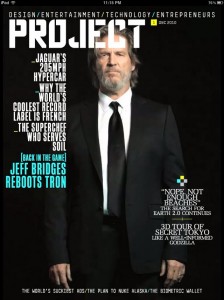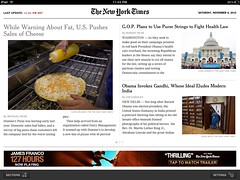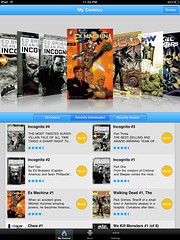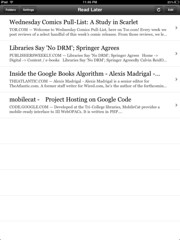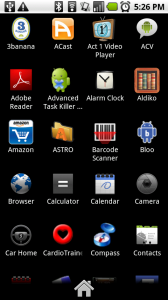I’ve spent a lot of time lately thinking (and writing) about eBooks, usually taking a pretty negative slant toward existing eBook publishers and vendors. DRM, distribution models, even publication timelines – much of it is a huge mess.
But I don’t want to seem too negative – I still think eBooks as a concept hold massive promise. It’s just many of the current implementations that’re flawed. So who’s doing it right? Here’s a handful of companies and products which I think are on the right track:
1. SpringerLink
Much of my thinking centers on the consumer publishing eBook panopoly – the Kindles, Nooks, and similar devices of the world. But there’s of course an academic side to things too. I have major beefs with a lot of the vendors and publishers who provide eBook packages to universities & colleges. Most of these are a topic for another post. But one thing I want to cover here: Many of them commit one of my pet peeve sins by making the books non-downloadable. They can’t be used on any kind of personal eReader device, or even viewed on a PC without an internet connection. But the SpringerLink collection that we subscribe to at UNC provides simple, clean, downloadable PDFs. There’s no password protection on the files, no DRM, no clunky web client we’re forced to use. They trust users to download a chapter and use it responsibly. As a result they’re the first eBook collection I search and show to students.
Sure, I wish SpringerLink had a more flexible format than PDF, but this is a step in the right direction. While other vendors like eBrary are rushing to finish off what will no doubt be limiting device-specific apps for their content, Springer lets readers choose how to consume their text.
2. Fictionwise
Fictionwise.com isn’t perfect, but they’re still my favorite eBook retailer. They sell a large portion of their titles DRM-free, which means they can be read on virtually any device or computer in perpetuity. There’s no license keys to maintain, no chance of a distributor retroactively taking back a sale. They also provide an archive of my purchases – I first bought a title from them in 2003, and I can re-download that book as much as I want today. I can even still get to the titles I purchased which they no longer sell. I wish their catalog of non-DRMed books would grow, especially among current bestsellers, but Fictionwise is still the only place I buy my eBooks from today.
(One caveat – Barnes & Noble bought Fictionwise last year. I hope B&N lets FW keep its independence.)
3. Calibre
eBook file formats are far from standardized. There’s .epub, .lrf, .html, .mobi, .pdf… the alphabet soup goes on forever. And of course no one device or program supports them all. The situation is a head-scratcher, and that confusion costs consumers & students time and money. Once upon a time it was a nightmare trying to convert from one format to another. Then along came Calibre.
Think of it like itunes for eBooks. It converts from almost any format to any other format, provides sophisticated yet user-friendly metadata management, and even syncs files with eReader devices. As a bonus, it’s open source & free to download!
Calibre single-handedly increased my ability to read eBooks by roughly 100% (my very scientific measurement, yes), and decreased my frustration even more. It doesn’t work with files locked down via DRM, but that’s a fault of vendors and not Calibre.
4. Comics by Comixology
Technically this is about comics, not simple text, but either way it’s still eBooks of a different sort. Comics by Comixology (henceforth referred to as simply ‘Comixology’) is an iPhone app which sells downloadable comic books. Many of them are adapted from print versions, but optimized very well for the iPhone & iPod Touch’s smaller screen. Panels zoom in and out and flow together. And in a first for digital comics, Comixology even sells issues from many major print publishers like Marvel and Image.
The comics only function on the iDevices, of course, which is something that would usually bug me. But the user experience is so good that I’m willing to overlook it for now. And then comes what I like best about Comixology – the price. Most issues are either $.99 or $1.99, which frankly is what a comic book should cost in any form. Many print comics now cost $3.99, and then after that ripoff I have to find somewhere to store them. As a result, my comic buying in the last couple years has dropped way off.
So $.99 for something I don’t have to find storage space for is a very attractive alternative to me. Example: I recently wanted to read the newest Atomic Robo collection. Amazon charges $12.89 for the print version, down from an $18.95 list price. I picked up the whole thing on Comixology for $4.95, and had a great digital reading experience without taking up space on my living room shelves. Cost effectiveness trumps a lot for me. Many times publishers charge resellers like Amazon the same wholesale price for both print copies and eBooks. This baffles me to no end. Comixology and their content providers recognize how much cheaper digital distribution is, and adjusted their prices accordingly.
I consume comics differently than I consume books. Comics by Comixology (despite their awkward name) is smart enough to realize that I’m not alone in this, and found a way to make the restrictions I usually foam at the mouth over become a palatable choice.
(note: Comixology has multiple apps for the iPhone, and I’m talking about the one specifically called ‘Comics by Comixology’ here.)


